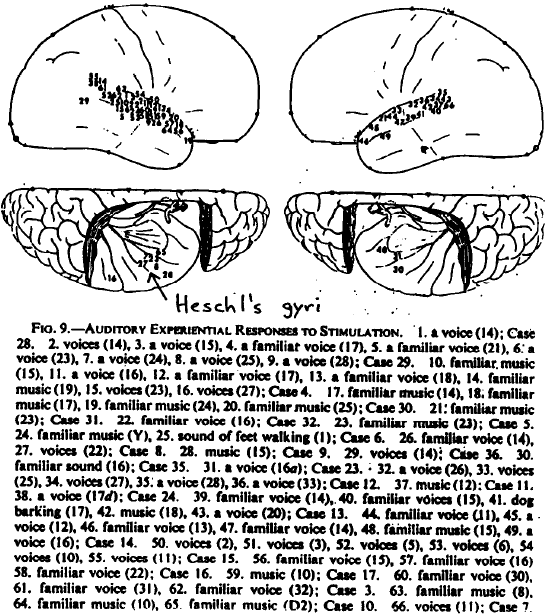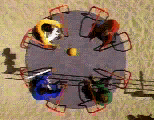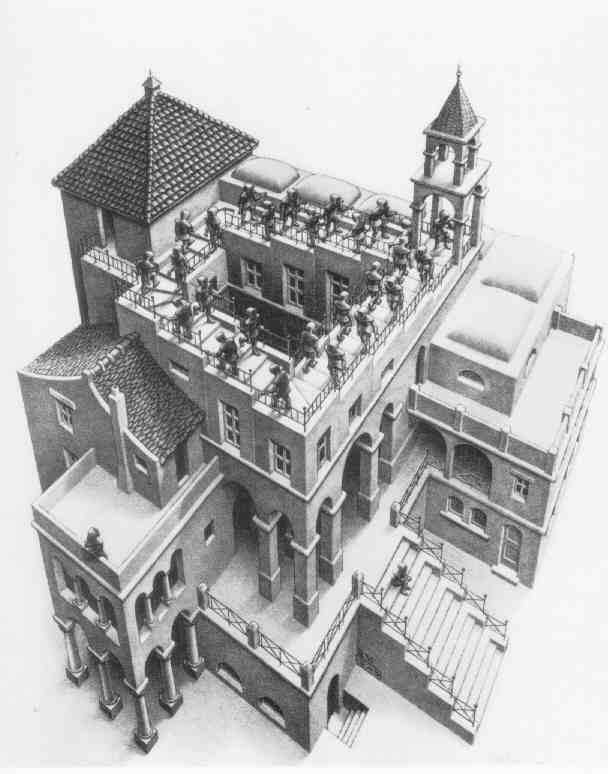TED Talks
(My last post was almost two months ago! I never intended to neglect “best thing” for so long, but all I can say is that I have been very busy. And now I have learned that the momentum of pausing a thing like this can be ridiculously self-maintaining… as I suppose momentum tends to be. Argh.)
Tonight I realized that my best professor friend ever, Deborah Gordon, gave a TED Talk back in 2003 about her work on ants. The video has just been posted on the TED Talks site. It’s a great introduction to a very interesting subject, and I count myself as lucky to have participated in the exact bits of tedious work she describes in that talk. If you haven’t seen her speak before, you’ll get to see some of her characteristic say-it-exactly-how-it-is-but-somehow-it’s-funny comments.
In other news, my current advisor, Tod Machover, will be speaking at this year’s TED conference. So I’ll be looking out for that one.
…And one more, from last year, by our soon-to-be-departed (a.k.a. soon-to-be-much-missed), TED-regular John Maeda.
Martin Wattenberg’s advice to me
Tonight I went to see Martin Wattenberg (from IBM’s Visual Communication Lab) talk about visualizing the patterns in Wikipedia edit histories (see history flow and chromogram). It was very fun, very interesting, and makes me think it’s possible to have a job that feels like play.
Afterwards I asked Martin if he had any advice for me, as I’m about to embark on my Masters thesis work, which is really just a big visualization project devoted to looking at people’s music collections. I was wondering what kinds of coding tools he’d recommend. (All of his Wikipedia visualizations were built in Java.) He said, “You’ve got one big question to answer first… Do you want to put this on the web, or not?” If I want it on the web, he says, go Flash; if not, try Processing. And he strongly suggested making it for the web, because that creates the possibility for an instant community and lets the project take on a life of its own.
Thursday, November 15, 7-9 pm
Visualizing Wikipedia: A tale of life, love, and bureaucracy
Martin Wattenberg and Fernanda Viegas (in spirit) , IBM Visual Communication Lab
Abstract: We report on Wikipedia’s evolution from a curiosity to a point of first
reference for millions. Applying data visualization techniques to
Wikipedia’s historical archives uncovers a story in three acts: life, love,
and bureaucracy. “Life” refers to the impressive ability of Wikipedia to
heal itself after vandalism and errors. “Love” is reflected in the
overwhelming scale of individual production and the passion shown by devoted
editors. And bureaucracy–an unexpected aspect of a free-spirited
community–is becoming prevalent as the site scales, with emerging
formalized processes and roles that help ensure quality.
Preparing for the Thesis
This afternoon was 3.5 hours of “rapid-fire”, “elevator-pitches” in the Media Lab’s Thesis Preparation course. So all 33 of the 2nd-year Masters students presented in 3 minutes what they hope to do for their Masters work this year.
The best part of an activity as draining as this is to walk away from it knowing that tons of awesome stuff is going to happen in the lab this year.
Here are some of the projects we can all look forward to:
- Programmable Matter — little cube automata that can be programmed to move relative to each other with electromagnetics.
- Cross-cultural Music Transformation — a translator for one culture’s musical style into another.
- Hi-Res, Low-cost Holographic Video
- “Comm.unity” — A platform that learns our social relationships and uses those to enable easy transfer of data between mobile devices in our social network.
- “Intelligent Stickies” — ink recognition, location awareness, and commonsense knowledge in Post-its.
- Investigating the placebo effect in active medicines — How does the packaging/branding change the effectiveness of a drug?
- Transforming digital content as it is copied and shared. Exploring making digital media more like analog media, which bears traces of previous usage.
- Wearable, wireless sensing for sports medicine, specifically for baseball pitchers.
- “E15” — a new way to browse the web.
- A digital platform for creation of interactive art in a networked environment.
- Persuasive Robotics — How can robots affect our attitude and behaviors? How is robot-human interaction different from human-human interaction?
“Visual Music” lecture
I gave my first lecture today. It was a 2.5-hour class on visualizing music, part of the Musical Aesthetics & Media Technology class I am TA-ing.
I spent much of the last few days preparing for this, and I found some impressive examples of visualizing music from the past few hundred years. In fact, there were so many examples that one of the hardest parts of preparing for the talk was defining its scope. I chose the examples I thought were most relevant to telling my version of the story, including Klee, Kandinsky, Oskar Fischinger, the Whitney brothers, Fantasia, all the way up to Ratatouille, the Music Animation Machine, and Martin Wattenberg’s The Shape of Sound. You can see all of these here, in my presentation:

Click image above to download interactive QuickTime slideshow (4.2 MB)
Underlined texts are link-outs, and you can use arrows to navigate through the show.
My favorite example of all is Oskar Fischinger’s Allegretto, which blew me away. Unfortunately I can’t find this online, but there is a fantastic DVD with that video available here.

(Tomorrow or Friday I will follow up with a set of links that cover the best examples of visual music that I found, including a couple of killer blog finds. That set will be much larger than what I was able to cover in class today.)
I’m so lucky.
I’m trying to be better about reminding myself how lucky I am, in so many ways. I tend to forget these things, and I end up taking much of it for granted. One of the things I’ve certainly taken for granted is the place I went to college.
I’ve spent a few days during the past week working in the Stanford libraries — I’m out in the Bay area for a long vacation, and am trying to get some work done here and there.
It’s just amazingly beautiful here. The campus is huge, open, green, and sunny. Right now I’m on the second floor of Meyer, looking out at Hoover Tower and the enormous eucalyptus in front of Green Library. When I was here for school, I just thought this was normal… laying around on the grass, skating at night down the floors of the parking garages, cooking dinner for my co-op, jumping over to the city, sitting out in the sun next to the red fountain, dashing off on my bike from Mirrielees to the Med School. I was so absorbed in my personal life and classwork that I don’t know that I ever stopped to realize what I was a part of. It’s strange how you grow to take the most familiar things for granted.

How much do I move when I sleep?
For my final project for sensors class, I wore accelerometers on my head, arm, and leg for a full night’s sleep, and tried to track how much I moved during the night, and which positions I tend to sleep in.
Main findings:
- I’m a side sleeper.
- I like staying in one position for about 40 minutes at a time.
- That period of time gets shorter as I sleep longer.
I wrote up some quick notes about the project here.
Hedy Lamarr and frequency hopping
 We’ve been learning about radio frequency transmission in sensors class, and today Ari told us about how actress Hedy Lamarr and composer George Antheil came up with the idea of frequency hopping to avoid jamming of radio-controlled torpedoes during WWII. The best part was their idea to use a roll from a player piano, on both the torpedo and transmitter, to change the transmission frequencies. I had fun looking at their patent here.
We’ve been learning about radio frequency transmission in sensors class, and today Ari told us about how actress Hedy Lamarr and composer George Antheil came up with the idea of frequency hopping to avoid jamming of radio-controlled torpedoes during WWII. The best part was their idea to use a roll from a player piano, on both the torpedo and transmitter, to change the transmission frequencies. I had fun looking at their patent here.
From http://hypatiamaze.org/h_lamarr/scigrrl.html:
Hedy knew that “guided” torpedos were much more effective hitting a target, a ship at sea for example. The problem was that radio-controlled torpedos could easily be jammed by the enemy. Neither she nor Antheil were scientists, but one afternoon she realized “we’re talking and changing frequencies” all the time. At that moment, the concept of frequency-hopping was born.
Antheil gave Lamarr most of the credit, but he supplied the player piano technique. Using a modified piano roll in both the torpedo and the transmitter, the changing frequencies would always be in synch. A constantly changing frequency cannot be jammed.
They offered their patented device to the U.S. military then at war with Germany and Japan. Their only goal was to stop the Nazis. Unfortunately or predictably, the military establishment did not take them or their novel invention seriously. Their device was never put to use during World War II.
From http://en.wikipedia.org/wiki/Hedy_Lamarr#Frequency-hopped_spread_spectrum_invention:
Lamarr’s frequency-hopping idea served as the basis for modern spread-spectrum communication technology used in devices ranging from cordless telephones to WiFi Internet connections.
Lamarr was awarded by the EFF in 1997 for her contributions to this invention.
Gastric juices, glass slides, and familiar voices
Trivia from three experiments…
 Pavlov did all his dog experiments initially with the goal of collecting their gastric juices to study digestion. He only changed his research to conditioning after he realized the dogs tended to salivate before they even had the food. There is a picture of Pavlov’s taxidermied dog (left) on the Wikipedia page, and here is a little browser someone at Cold Spring Harbor is inspired enough to maintain, on all of Pavlov’s dogs.
Pavlov did all his dog experiments initially with the goal of collecting their gastric juices to study digestion. He only changed his research to conditioning after he realized the dogs tended to salivate before they even had the food. There is a picture of Pavlov’s taxidermied dog (left) on the Wikipedia page, and here is a little browser someone at Cold Spring Harbor is inspired enough to maintain, on all of Pavlov’s dogs.
Hubel and Wiesel accidentally stumbled onto the start of their Nobel-prize winning discovery on the visual cortex in cats, by getting a slide stuck at an angle while loading it to view in the projector. The edge of the glass slide created a sharply contrasting line at an angle that triggered activity in the cat brains.
After unjamming the slide, they slowly pushed it into its slot. Suddenly the electrode monitor started firing like “a machine gun.â€
(from http://www.nytimes.com/books/first/h/horgan-mind.html?_r=1&oref=slogin)
 Wilder Penfield electrically stimulated epileptic patients’ brains in an attempt to map the human cortex. He found that stimulation in the superior temporal lobe could give the patient a sensation of familiar voices, music, and memories. I find the accompanying picture ((from Penfield and Perot, 1963)) very amusing. (“sound of feet walking”??)
Wilder Penfield electrically stimulated epileptic patients’ brains in an attempt to map the human cortex. He found that stimulation in the superior temporal lobe could give the patient a sensation of familiar voices, music, and memories. I find the accompanying picture ((from Penfield and Perot, 1963)) very amusing. (“sound of feet walking”??)
The mysterious Coriolis force
 I remember the term “Coriolis force” from some ancient high school physics class, I think. But when Joe P showed us this phenomenon again in class last week, I could swear I’ve never ever thought about it before. It’s a little baffling to me at the moment (and therefore worth thinking about!).
I remember the term “Coriolis force” from some ancient high school physics class, I think. But when Joe P showed us this phenomenon again in class last week, I could swear I’ve never ever thought about it before. It’s a little baffling to me at the moment (and therefore worth thinking about!).
Compare the simple video on the Coriolis force Wikipedia page with the merry-go-round video on this page. Now figure out how cyclone winds rotate along the Earth’s surface… and you’re all set!
Hearing the Escher staircase
 You know this staircase, right?
You know this staircase, right?
In class, we heard the auditory analog of this visual illusion: the “Shepard-Risset glissando”, named after the two guys who worked on it. [sound sample]
The trick here is that the sound contains four notes all an octave apart, with the loudness of each note sneakily adjusted as the pitch of the notes climbs.
To understand this trick better, here’s a good visualization and demo of the discrete Shepard scale:
Visualization of the Shepard Effect
Much more discussion of how it all works on the Shepard tone Wikipedia page, which includes another sound sample of the glissando…
An independently discovered version of the Shepard tone appears at the beginning and end of the 1976 album A Day At The Races by the band Queen. The piece consists of a number of electric-guitar parts following each other up a scale in harmony, with the notes at the top of the scale fading out as new ones fade in at the bottom. Lose Control by Missy Elliott also seems to feature an ascending Shepard tone as a recurring theme (via the sampled synthesizers from Cybotron’s song “Clear”.) “Echoes”, a 23-minute song by Pink Floyd, concludes with a rising Shepard tone.